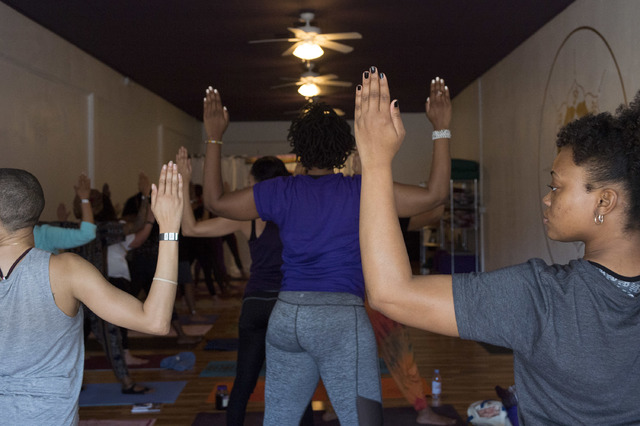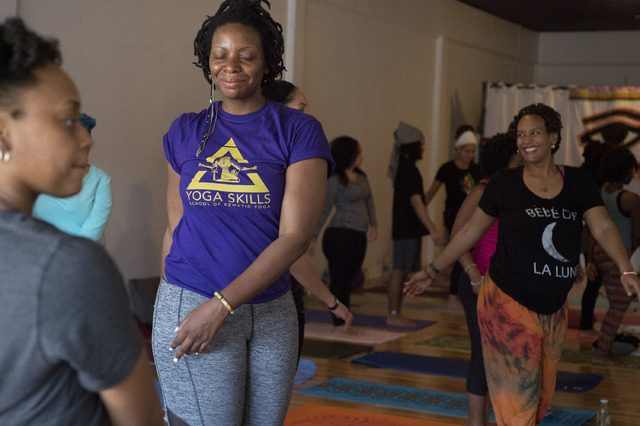In Kemetic yoga, the spiritual benefits transcend the physical
On a balmy Saturday afternoon in the Arts District, a crowded room of yogis lunges forward in unison, each person pressing one hand against the floor while reaching the other toward the ceiling.
“Whatever calmness that you develop here, you want to maintain it through your whole day,” the instructor Yirser Ra Hotep says from the front of the room.
The words and movements may sound and look familiar to anyone who has taken a traditional Indian yoga class. Ra Hotep, however, is teaching a Kemetic yoga workshop, a form of yoga with origins thousands of miles away from India.
Kemetic yoga is based on ancient Egyptian practices and philosophies. (“Kemet” was one of the original names for Egypt.) It incorporates some of the same poses as Indian yoga — such as child’s pose or warrior pose — because they are positions humans naturally gravitate toward to condition certain parts of the body. The poses that anchor the sequences differ and derive from the postures of Egyptian gods in carvings on temple and pyramid walls. When practitioners of Kemetic yoga do one of these specific poses, they are channeling the principles that god represents as well as reaping the physiological benefits of the position.
“I’ve never seen any other culture that has those particular postures,” Ra Hotep says. He’s a Chicago-based Kemetic yoga instructor with 42 years of experience who helped resurrect Kemetic yoga in the 1970s.
While Kemetic yoga does have many of the same mental and physical benefits as yoga of Indian origin, it’s also very slow paced and relaxing with an emphasis on releasing tension from the body.
In general, the physical benefits are secondary to the spiritual benefits of Kemetic yoga. Through a breathing sequence called the “Rule of Four Breathing,” practitioners move and circulate energy throughout the body with the ultimate goal of bringing oneself in harmony with the universe.
“The physical benefits are side effects to me. My main goal is to be more focused, to have self-love, to have determination, to have will, concentration,” says Maticia Sudah, a Las Vegas-based Kemetic yoga instructor trained by Ra Hotep. She teaches classes regularly at the West Las Vegas Arts Center and Yoga Kandy.
Sudah’s said many of her students have not consistently practiced yoga before joining her Kemetic yoga classes, in part because they did not feel welcome in yoga classes that did not tend to attract a diverse range of attendees.
“They did not feel comfortable in these classes just based on how they were treated or how they were perceived or whatever reason it was,” Sudah says. “I believe to have a teacher that was a direct reflection of them, that was a likeness of them, that was a larger bodied person of the same culture was very comforting because there are not a lot of African-American yoga teachers around.”
For many black attendees of Ra Hotep’s classes and workshops in the U.S. and abroad, practicing Kemetic yoga is a way to reclaim their history.
“If you’re a black person living in America, your ancestors were forced to give up their names, their language, their religion. So many black people, once they become aware and conscious of this, of these facts, they start to seek something different,” Ra Hotep says.
“This is something that comes from our ancestors that we can have ownership of.”
Read more from Sarah Corsa at reviewjournal.com. Contact her at scorsa@reviewjournal.com and follow @sarahcorsa on Twitter.








































